5.4 Visual Arts
Workshop of Robert Campin, Annunciation Triptych (Merode Altarpiece)
Video URL: https://youtu.be/q1X0Lj7YEMs?si=clv8BYKWpRd9vDEw
Jan Van Eyck, The Arnolfini Portrait
Video URL: https://youtu.be/9ODhKqFaugQ?si=SXpm-LDU5n3QJurp
Hieronymus Bosch, The Garden of Earthly Delights
To write about Hieronymus Bosch’s triptych, known to the modern age as The Garden of Earthly Delights, is to attempt to describe the indescribable and to decipher the indecipherable—an exercise in madness. Nonetheless, there are a few points that can be made with certainty before it all unravels.
The painting was first described in 1517 by the Italian chronicler Antonio de Beatis, who saw it in the palace of the counts of Nassau in Brussels. It can therefore be considered a commissioned work. The fact that the counts were powerful political players in the Burgundian Netherlands made the palace a stage for important diplomatic receptions and the work must have caused something of a sensation with its viewing audience, since it was copied, both in painting and tapestry, after Bosch’s death in 1516. We can assume, therefore, that Bosch’s bizarre lexicon of human congress must have held some appeal, or some meaning, for a contemporary audience. In a period marked by religious decline in Europe and, in the Netherlands, the first blush of capitalism following the abolition of the guilds, the work has often been interpreted as an admonition against fleshly and worldly indulgence, but that seems a rather prosaic purpose to assign to a highly idiosyncratic and expressively detailed tour-de-force. And, indeed, there is very little agreement as to the precise meaning of the work. It is a creation and damnation triptych, starting with Adam and Eve and ending with a highly imaginative through-the-looking glass kind of Hell. No one really knows why Bosch imagined the world in this particular way.
outer panels, painted in grisaille (monochrome), join to form a perfect sphere—a vision of a planet-shaped clear glass vessel half-filled with water, interpreted to be either the depiction of the Flood, or day three of God’s creation of the world (which has to do with the springing forth of flowers, plants and trees, in which case he’s guilty of heedless over-watering).
A tiny figure of God, holding an open book, is found in the uppermost left corner of the left panel, and the inscription that runs along the top of both panels can be translated to read “For he spoke, and it came to be; he commanded, and it stood firm,” which is from Psalm 33.9. If one thinks of the outside panels as the end of the entire pictorial cycle, rather than its beginning, then this image could easily be a depiction of the Flood, sent by God to cleanse the earth after it was consumed by vice.

This path towards vice is mapped in the inner panels of the triptych. The outer panels are therefore intended to provoke meditative purgation, a cleansing of the mind. It should be pointed out that this work, like Bosch’s Hay Wain triptych (also framed by a creation and damnation scene), is a triptych only in form; neither depict the conventional arrangement of a tripartite altarpiece because their center panels do not include religious figures or even religious scenes. What Bosch seems to have invented is an entirely new form of secular triptych, one that functioned kind of like a Renaissance home theater package for wealthy patrons.
The first panel depicts God, looking like a mad scientist in a landscape animated by vaguely alchemical vials and beakers, presiding over the introduction of Eve to Adam (which, in itself, is a rather rare subject). Although they are precisely located in the center foreground, in scale Adam and Eve—as well as God—are precisely as important as the other creatures in this paradisiacal garden, including an elephant, a giraffe (straight out of Piero de’ Cosimo) a unicorn and other more hybrid and less recognizable animals, along with birds, fish, other aquatic creations, snakes and insects.
The introduction of woman to man, in this setting, is clearly intended to highlight not only God’s creativity but human procreative capacity. In the hierarchy of God’s handiwork, Adam and Eve represent his most daring achievement, as though after he’d made everything else he thought he needed to leave a signature on the world in which he could recognize himself. It’s a matter of conjecture, when one proceeds to the central panel, as to whether Bosch is saying that the creation of man, on whom God conferred free will, might have been a divine mistake.
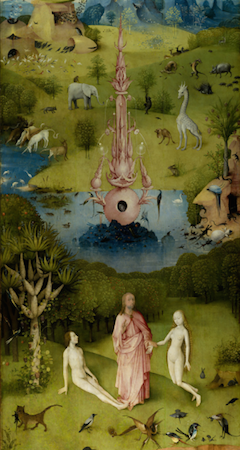
His encounter with the Italian Renaissance in Italy.
Dürer’s diaries tell of his fascination not only with Italian art but with the status of the Italian artist. Italian artists were conceded expressive identities and rewarded with status and regard as intellectuals, while in Germany artists often remained respectable but anonymous artisans.
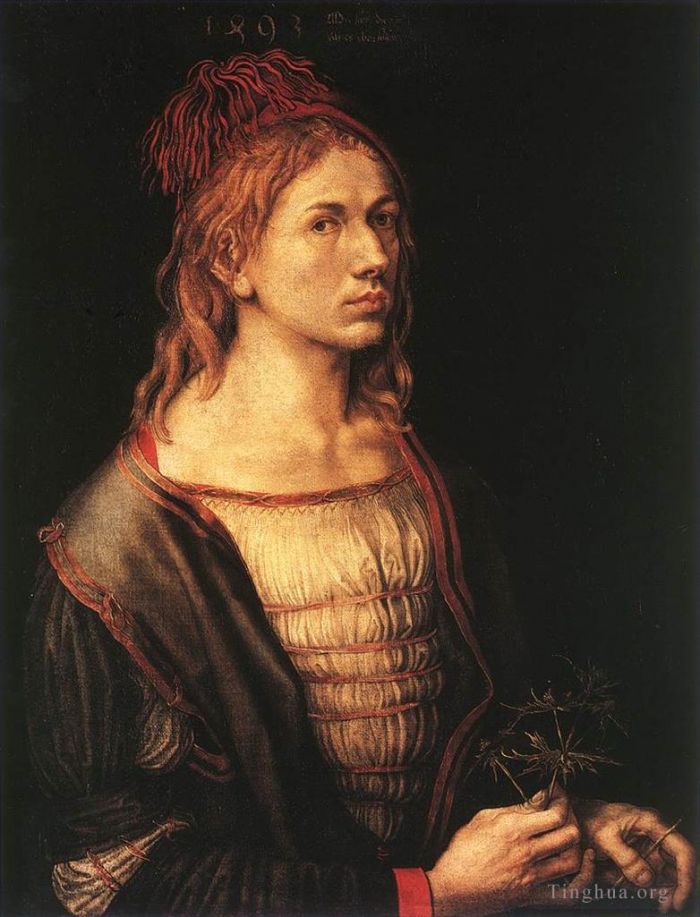
Copyright: Dr. Bonnie Noble, “Albrecht Dürer, Melencolia,” in Smarthistory, November 20, 2015, accessed June 14, 2024, https://smarthistory.org/albrecht-durer-melencolia/.
Albrecht Dürer’s Woodcuts and Engravings
Video URL: https://youtu.be/C3DmiEsvs6U?si=DNzNgMfdu1sY7Hf_
Matthias Grünewald, Isenheim Altarpiece
Video URL: https://youtu.be/TuO2PNxGC5s?si=LsExVJpxAvFmqCJz
The Carpet and the Globe: Holbein’s The Ambassadors Reframed
Video URL: https://youtu.be/qOvxK_3HEco?si=EMzMXSgdX-u6MoVG
Anthonis Mor, Portrait of Mary Tudor
A regal presence. An iron will. A hint of impatience. A suggestion of a smile. These are some of the traits that one can discern in the countenance of Mary I, more commonly known as Mary Tudor, Catholic queen of England and Ireland, who reigned from 1553 to 1558. This acutely observed and beautifully understated portrait was painted by the Netherlandish artist Anthonis Mor (also known as Antonio Moro), who worked as court painter to the Habsburg dynasty.
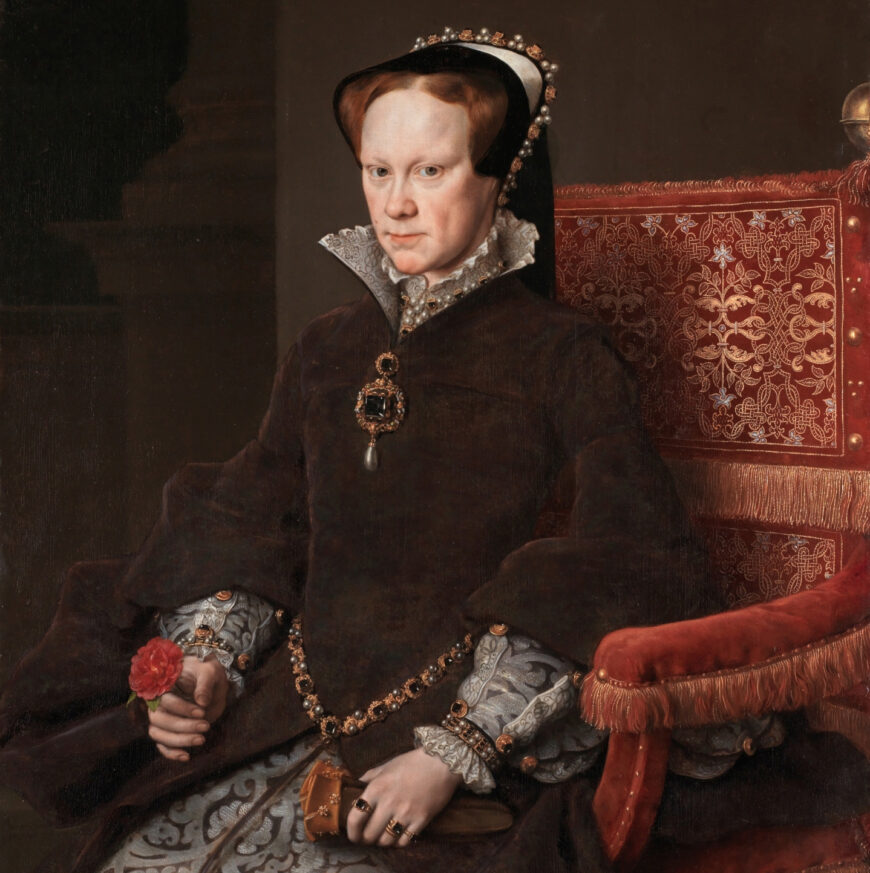
Due to her own royal lineage, Mary was the first woman to rule as monarch in England and Ireland as “Queen Regnant”: she did not become monarch through marriage, but ruled in her own right—and on her own terms.
The portrait, painted from life, was commissioned by Charles V, Holy Roman Emperor, to commemorate the marriage of Mary to Charles V’s son, Prince Philip, who ruled as Philip II, king of Spain, from 1556 until 1598, with whom Mary ruled England and Ireland jointly from 1554 until her death in 1558, and with whom she hoped to have an heir. Mary, however, who endured ill health throughout her life, suffered “phantom” or false pregnancies (known as pseudocyesis) and two miscarriages.
Henry VIII, king of England and Mary Tudor’s father, had broken with the Catholic Church of Rome in 1534 and had created the Protestant Church of England through the Act of Supremacy, which had made the English monarch head of the Church of England. In her courage, in her brutal impatience, Mary was very much her father’s daughter. Notoriously, Henry VIII had two of his six wives tried and executed for adultery and treason (Anne Boleyn and Katherine Howard). A pious and uncompromising Catholic, Mary’s overarching ambition was to re-establish papal supremacy in her kingdoms and—far more difficult—to reconvert the hearts and minds of the English people to the Catholic Church.
Mor’s painting is uncharacteristic of royal portraits produced at the English royal court, which usually depicted monarchs in three-quarter length, in a standing position, as, for example, in Hans Eworth’s 1554 portrait of Mary Tudor. Instead, in Mor’s portrait Mary is depicted in three-quarter profile, seated in an exquisitely embroidered crimson velvet chair, a symbol of authority. She is wearing a beautifully embroidered dress with a foliate pattern and a purple overgarment. Pearls and precious stones adorn her headdress, cuffs, and belt.
The royal, papal, and imperial connotations of the crimson velvet chair and the purple overgarment cannot have been lost on anyone who viewed the portrait. It is a portrait whose iconography seems to challenge the English Protestant legacy of Mary’s father, Henry VIII, and of her half-brother, Edward VI. However, although a Catholic, Mary was still a Tudor, and the rightful successor of her younger brother, Edward. This is the reason why her accession to the throne was greeted with wide popular support. Mary is holding a red rose in her right hand. The rose is often a symbol of the Virgin Mary. It also signifies the Passion of Christ (his arrest, trial and suffering) and Christ’s sacrifice. The rose can also be read as a symbol of Mary’s dynastic heritage since it was the symbol of the House of Lancaster, to which Mary could trace her paternal line.
Mary wears a diamond ring on her left hand, and a diamond and pearl pendant hangs from her neck. The portrait thus speaks of another Catholic dynastic history: the very powerful Habsburgs. What is more, the column or pillar of authority in the left background (which can also be interpreted as a symbol of the Virgin Mary) suggests imperial dominion: Charles V’s impresa was a crowned eagle separated by twin columns, which represent the Pillars of Hercules.
The imminent marriage, and the fact that according to the Act of Marriage of 1554, Philip would rule jointly with Mary, caused a Protestant rebellion led by Sir Thomas Wyatt, which was successfully put down.
Mary’s marriage to Philip was not a match made in heaven. For the majority of her subjects, whose anti-papal and anti-Spanish hostilities had long been shaped by the policies of Henry VIII, she had married an enemy of the state. For Mary, it must have been a relatively joyless marriage, as Philip (who had mistresses) seems to have been less than enamored to have married a woman eleven years his senior. However, should Mary have produced an heir, preferably male, with Philip, it would have ensured a Catholic future for Tudor England and Ireland.
There is no disputing the fact that during Mary’s reign 237 men and 52 women, mostly of humble backgrounds, were burned at the stake for refusing to recant their “heretical” Protestant beliefs and swear allegiance to the Catholic faith. This earned Mary the infamous nickname “Bloody Mary” from later Protestant Tudor writers, and has tarnished Mary’s reputation ever since.
Copyright: Michael John Partington, “Anthonis Mor, Portrait of Mary Tudor,” in Smarthistory, May 5, 2024, accessed June 14, 2024, https://smarthistory.org/anthonis-mor-mary-tudor/.
Portraits of Elizabeth I: Fashioning the Virgin Queen
The earliest surviving image of Elizabeth I was painted when she was a princess, about a year before her father died. This portrait shows the fair-haired, dark-eyed girl, about thirteen years old, gazing spookily out at the viewer. At this point her expected role was to marry and form alliances for the good of the dynasty. Her crimson dress and exquisite jewelry reveal her royal status. The books in her hands and propped open behind her advertise her learning and piety, while her neat figure and self-possessed stance allude to her potential as an attractive bride.
Elizabeth’s femininity, which made her a suitable pawn in marriage negotiations, posed a problem when she became queen. In Tudor society women were deemed weaker than men: destined not to rule, but to be ruled by their fathers, brothers and husbands. But what if a woman became monarch? Some of these problems had already been addressed in the previous reign: Mary I’s government issued the 1554 Act Concerning Regal Power, which effectively declared that monarchy trumped gender. A woman on the throne was both king and queen, or as Archbishop of York Nicholas Heath put it in 1559, Elizabeth was “our sovaraigne lord and ladie, our kinge and quene, our emperor and empresse.” [4]
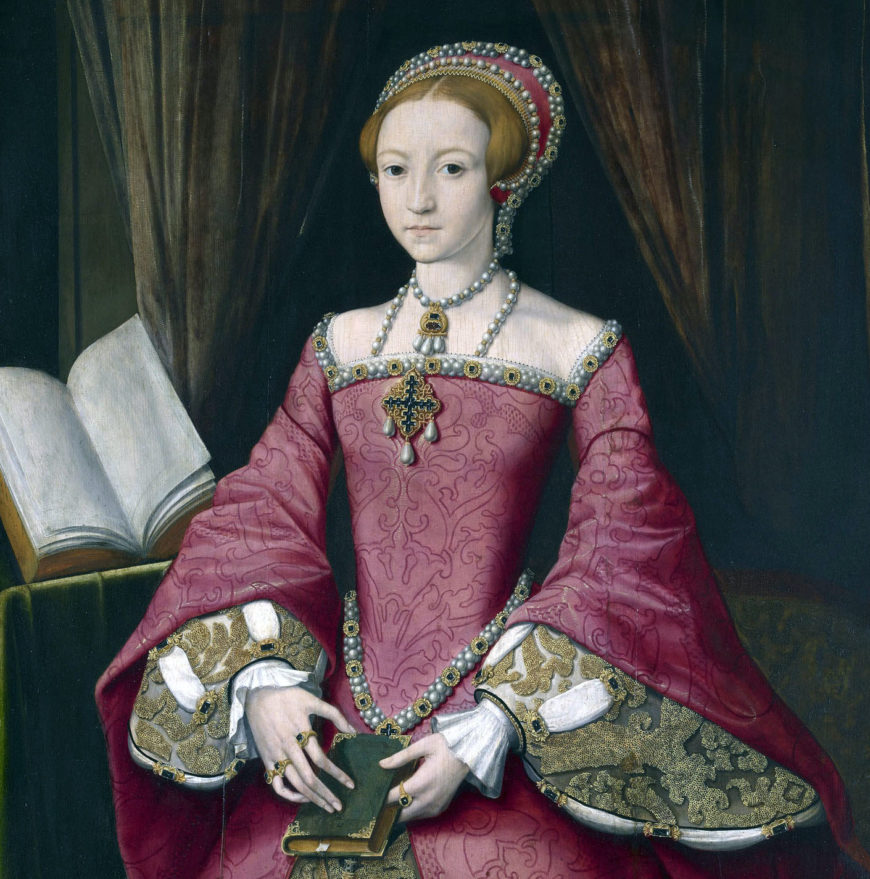
The earliest surviving portraits of Elizabeth I as queen register this androgyny. Images such as the Clopton Portrait often show Elizabeth with a book to indicate her erudition and dedication to the Protestant faith, recalling the image of her as a princess. [5] Yet in contrast to that earlier image the line of her body is hidden under her black clothing. Shoulders square, hair tucked away, Elizabeth is made to appear almost masculine: a conscious strategy to legitimize her as ruler.
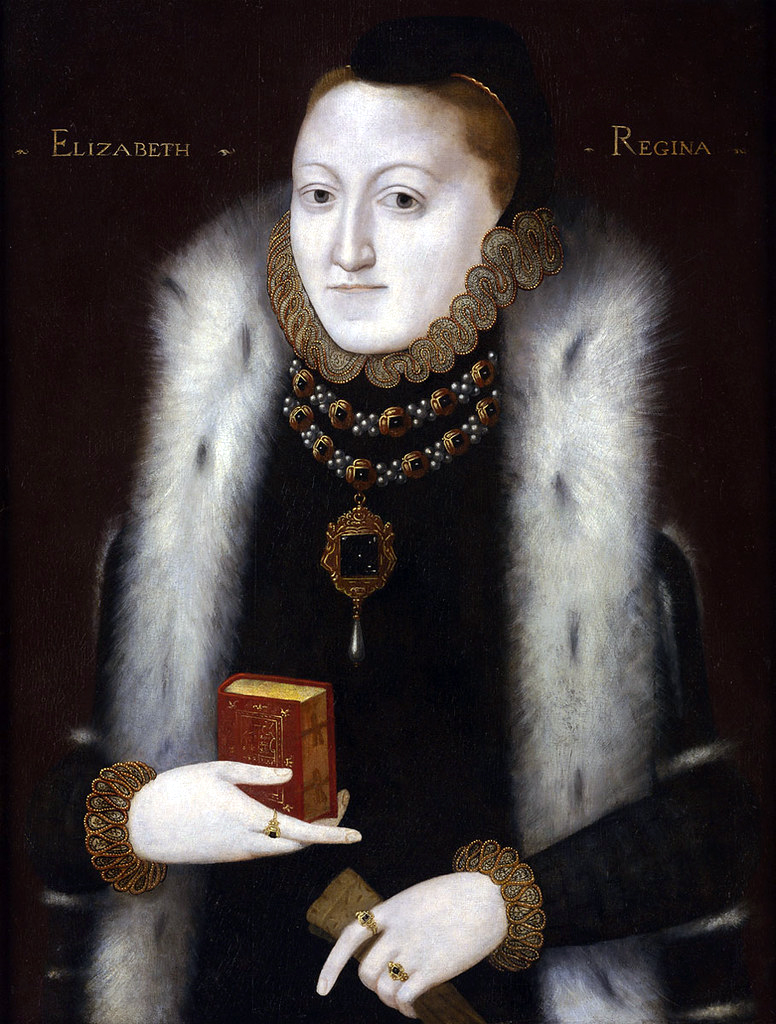
In 1562 Elizabeth caught smallpox and nearly died. The threat this posed to the political and religious situation in England terrified her courtiers, and they pressured her to marry and produce an heir. In 1563 a Draft Proclamation—never enacted—expressed the desire for a better image of Elizabeth, probably partly for use in marriage negotiations, as “hitherto none hath sufficiently expressed the natural representation of her majesty’s person, favor, or grace, but that most have so far erred therein as thereof daily are heard complaints amongst her loving subjects.” The Draft Proclamation indicates more generally that poor-quality images were felt to undermine Elizabeth’s authority. It concludes with an ambition “to forbid and prohibit the showing or publication of such [images] as are apparently deformed” until an approved image could be created. This approved image may have taken the form of the Hampden Portrait, the first full-length image of Elizabeth. Elizabeth rests her hand on an x-frame chair under a cloth-of-gold canopy of state—emblems of her authority. She is wearing the red-and-white colors of the Tudor dynasty, and holding a carnation, a common symbol of courtship (as we see in a portrait of Simon George of Cornwall). To the right a verdant band of flowers, foliage and fruits—frequently in pairs—evokes fertility: Elizabeth was entering the marriage market. For two decades she toyed with marriage negotiations, but in the late 1570s finally seemed to have met her match in Francis, Duke of Anjou, brother and heir presumptive of the French king. Unfortunately by now Elizabeth was in her mid-forties: her courtiers felt that childbirth was too risky, and if she died childless while married to Anjou, England could become French property. They advised against the marriage, and negotiations were finally broken off in 1581.
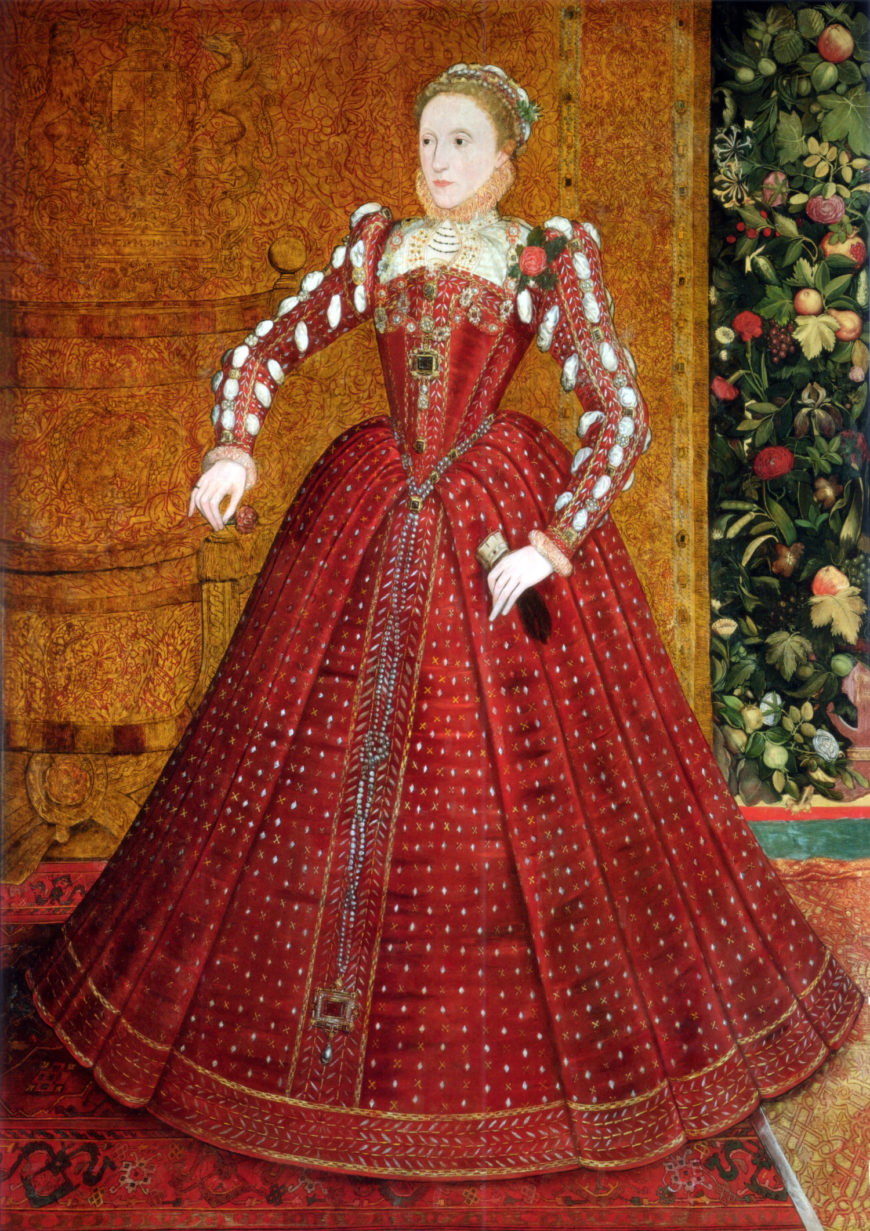
Not coincidentally, around this time portraits of Elizabeth make increasingly overt reference to Elizabeth as the “Virgin Queen.” Unmarried women were expected to remain virgins, as Christianity only permitted sex within marriage. Around 1580 several “sieve portraits” were painted, alluding to the ancient Roman Vestal Virgin Tuccia, who proved her chastity by carrying water in a sieve from the Tiber to the temple. In the version painted by Quentin Metsys the Younger, the sieve also becomes an emblem of discernment, labelled with the motto “a terra ilben / al dimora in sella” (the good falls to the ground while the bad remains in the saddle).
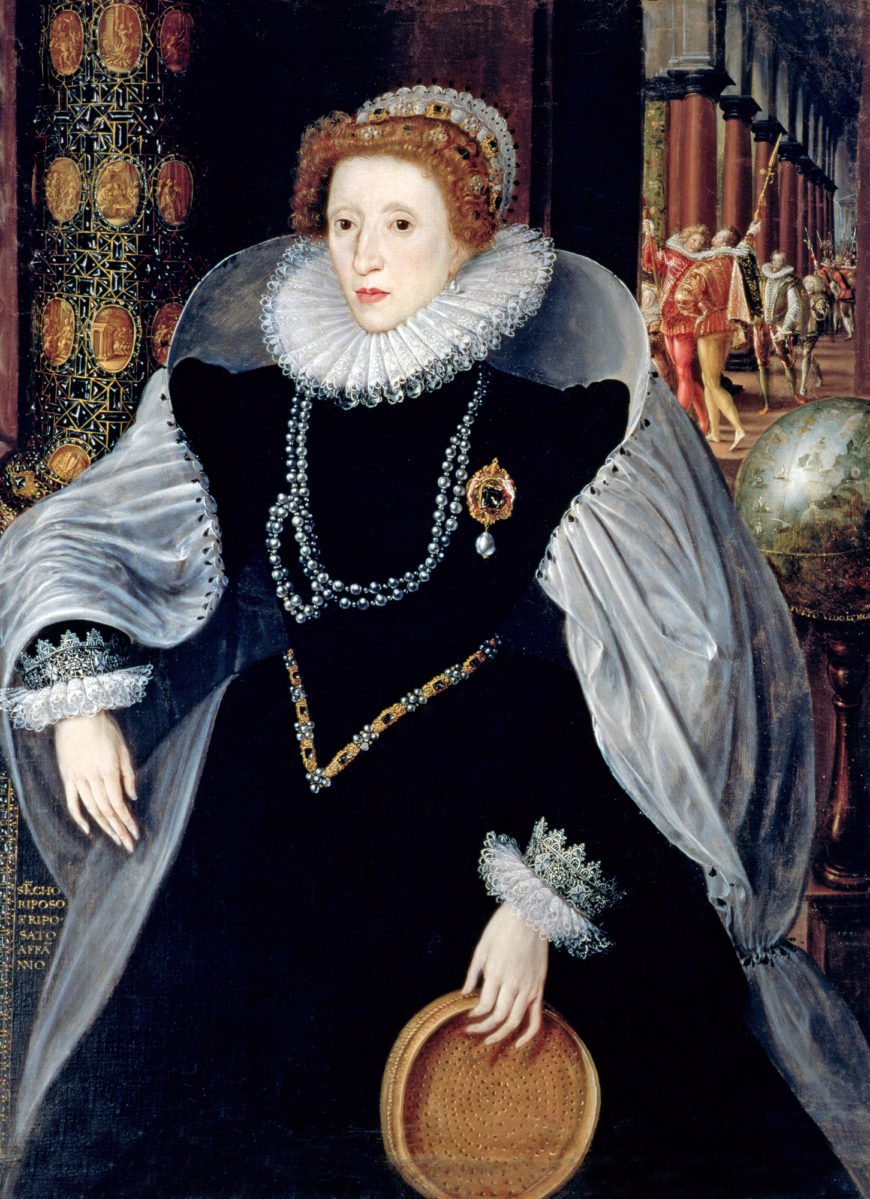
Much of the symbolism in this painting is standard in Elizabeth’s portraiture, in particular the column and globe, which refer to England’s imperial ambitions, but the column also reinforces the message of Elizabeth’s virginity and independence: studded with allegorical scenes referencing the classical story of Dido and Aeneas, it pointedly reminds the viewer of the love affair which temporarily distracted Aeneas from his destiny as founder of the Roman Empire. Here again androgyny lurks under the surface, as Elizabeth is identified not with the doomed lover Dido, but the masculine founder of Rome, Aeneas.
In the background we catch sight of the person who probably commissioned this portrait, Sir Christopher Hatton, identifiable by the golden hind on his cloak, a symbol taken from his heraldic crest. Hatton was a major opponent of the Anjou match: whether this portrait was intended to put pressure on Elizabeth by emphasizing her identity as the “Virgin Queen,” or to celebrate Hatton’s successful counsel after the fact, it demonstrates how portraits which on the surface seem to promote Elizabeth’s authority could also put forward an agenda that conflicted with, and even undermined, her own desires.
As Elizabeth’s reign wore on, her status as “Virgin Queen” became an increasingly important symbol of her devotion to her kingdom, and of the security of the realm. We see this in the iconic Armada Portrait which survives in three near-identical versions.
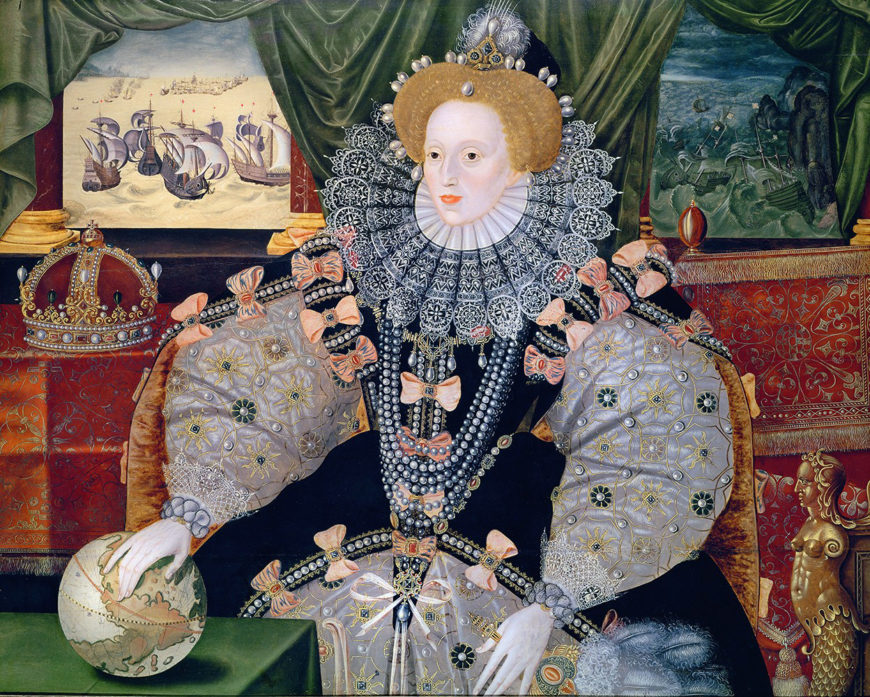
In the final decade of her reign, Elizabeth’s portraiture transforms her into England’s quasi-divine protectress. In the Ditchley Portrait, Elizabeth is represented at roughly life-size, but within the realm of the portrait she is a giantess, standing astride the globe. Her costume, with its huge sleeves and farthingale, all but eliminates the human quality of sex in favor of a more divine representation. Around her the sky changes from pale blue to stormy navy, as if she could control the elements with a flick of her fan. The (partly destroyed) inscription in the cartouche underlines these cosmic themes, referring to Elizabeth as “The prince of light, The Sun.” [7]
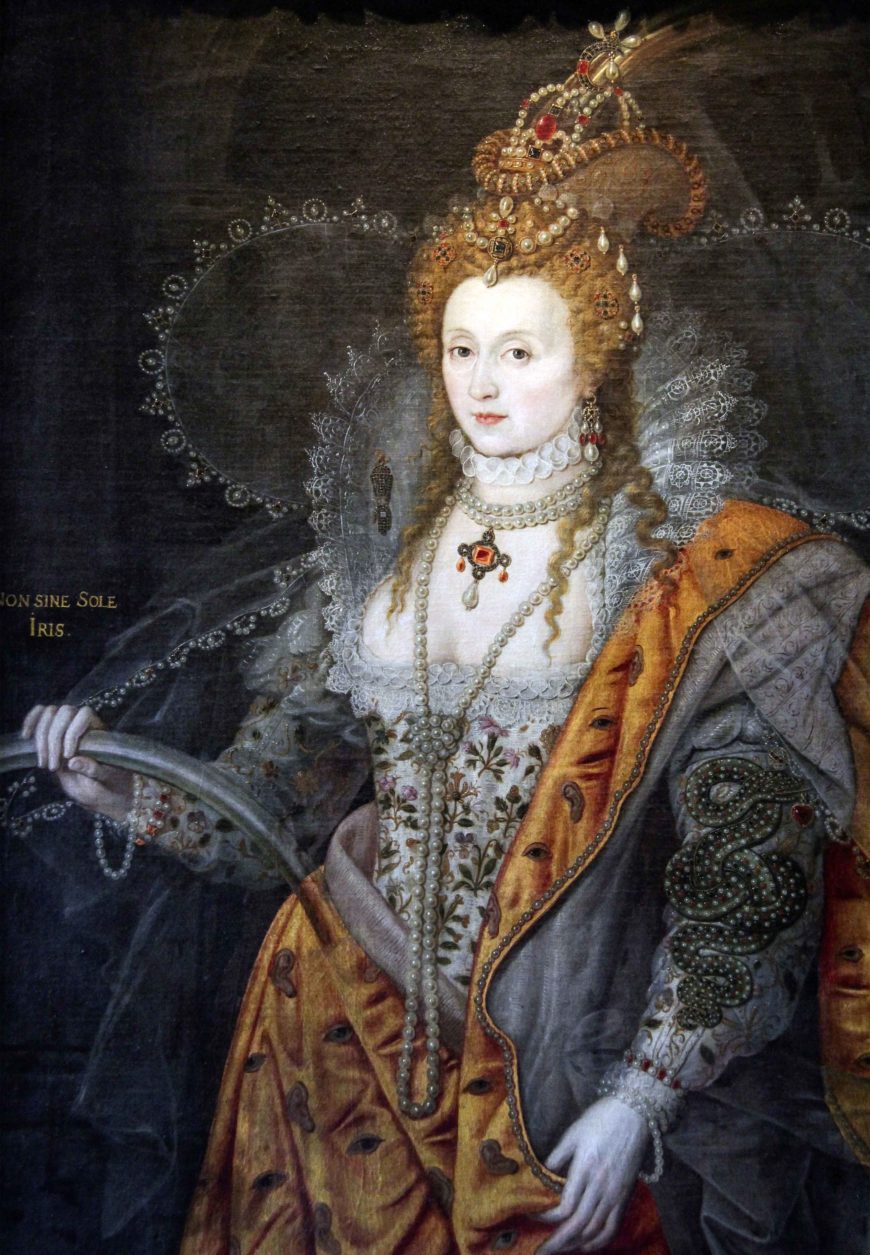
The Ditchley Portrait is unusual in that it shows Elizabeth as naturalistically aged. Most late images of Elizabeth, such as the Rainbow Portrait, show the queen as improbably youthful, a deliberate tactic designed to allay fears about the succession. Painted at the very end of her reign, the Rainbow Portrait seems to look back to the earliest images of Elizabeth as a princess: her body is feminized and the cut of her bodice is lower. Her hair flows down behind her head and strands fall across her elaborate ruff, evoking the Coronation Portrait, which was copied around this time from a lost original. Here at last, artists seem to have found a way of reconciling Elizabeth the woman with Elizabeth the divinely-ordained ruler. She retains emblems of divinity: eyes and ears speckle her cloak, symbolizing omniscience (and the networks of spies controlled by the Cecil family, probable patrons of this portrait) and in her hand she holds a rainbow, alluding to God’s promise to his people after the Flood, here evoking Elizabeth’s commitment to her kingdom. Now, at the end of a more than forty-year rule, artists and courtiers had finally solved the problem of how to represent Elizabeth. For artists, her successor James I would be altogether more straightforward, but far less iconic.
Baroque Art: An Introduction
While the Protestants harshly criticized the cult of images, the Catholic Church ardently embraced the religious power of art. The visual arts, the Church argued, played a key role in guiding the faithful. They were certainly as important as the written and spoken word, and perhaps even more important since they were accessible to the learned and the unlearned alike. In order to be effective in its pastoral role, religious art had to be clear, persuasive, and powerful. Not only did it have to instruct, but it also had to inspire. It had to move the faithful to feel the reality of Christ’s sacrifice, the suffering of the martyrs, and the visions of the saints.
The Church’s emphasis on art’s pastoral role prompted artists to experiment with new and more direct means of engaging the viewer. Artists like Caravaggio turned to a powerful and dramatic realism, accentuated by bold contrasts of light and dark, and tightly cropped compositions that enhance the physical and emotional immediacy of the depicted narrative.
Other artists, like Annibale Carracci (who also experimented with realism), ultimately settled on a more classical visual language, inspired by the vibrant palette, idealized forms, and balanced compositions of the High Renaissance. Still others, like Giovanni Battista Gaulli, turned to daring feats of illusionism that blurred not only the boundaries between painting, sculpture, and architecture, but also those between the real and depicted worlds. In so doing, the divine was made physically present and palpable.
Whether through shocking realism, dynamic movement, or exuberant ornamentation, seventeenth-century art is meant to impress. It aims to convince the viewer of the truth of its message by impacting the senses, awakening the emotions, and activating—even sharing—the viewer’s space.
The monarchs of Spain, Portugal, and France also embraced the more ornate elements of seventeenth-century art to celebrate Catholicism. In Spain and its colonies, rulers invested vast resources in elaborate church facades, stunning, gold-covered chapels and tabernacles, and strikingly realistic polychrome sculptures. In the Spanish Netherlands, where sacred art had suffered terribly as a result of the Protestant iconoclasm (the destruction of art), civic and religious leaders prioritized the adornment of churches as the region reclaimed its Catholic identity. Refurnishing the altars of Antwerp’s churches kept Peter Paul Rubens’s workshop busy for many years. Europe’s monarchs also adopted this artistic vocabulary to proclaim their own power and status. Louis XIV, for example, commissioned the splendid buildings and gardens of Versailles as a visual expression of his divine right to rule.
In the Protestant countries, and especially in the newly independent Dutch Republic (modern-day Holland), the artistic climate changed radically in the aftermath of the Reformation. Two of the wealthiest sources of patronage—the monarchy and the Church—were now gone. In their stead arose an increasingly prosperous middle class eager to express its status, and its new sense of national pride, through the purchase of art.
By the middle of the 17th century, a new market had emerged to meet the artistic tastes of this class. The demand was now for smaller-scale paintings suitable for display in private homes. These paintings included religious subjects for private contemplation, as seen in Rembrandt’s poignant paintings or even his prints of biblical narratives, as well as portraits documenting individual likenesses.
But, the greatest change in the market was the dramatic increase in the popularity of landscapes, still-lifes, and scenes of everyday life (known as genre painting). Indeed, the proliferation of these subjects as independent artistic genres was one of the 17th century’s most significant contributions to the history of Western art.
By the middle of the 19th century, the word had lost its pejorative implications and was used to describe the ornate and complex qualities present in many examples of 17th-century art, music, and literature. Eventually, the term came to designate the historical period as a whole.
In the context of the painting, for example, the stark realism of Zurbarán’s altarpieces, the quiet intimacy of Vermeer’s domestic interiors, and the restrained classicism of Poussin’s landscapes are all “Baroque” (now with a capital “B” to indicate the historical period), regardless of the absence of the stylistic traits originally associated with the term.
Scholars continue to debate the validity of this label, admitting the usefulness of having a label for this distinct historical period, while also acknowledging its limitations in characterizing the variety of artistic styles present in the 17th century.
Copyright: : Dr. Esperança Camara, “Baroque art, an introduction,” in Smarthistory, June 9, 2015, accessed June 14, 2024, https://smarthistory.org/a-beginners-guide-to-baroque-art/.
Gian Lorenzo Bernini, Ecstasy of Saint Teresa
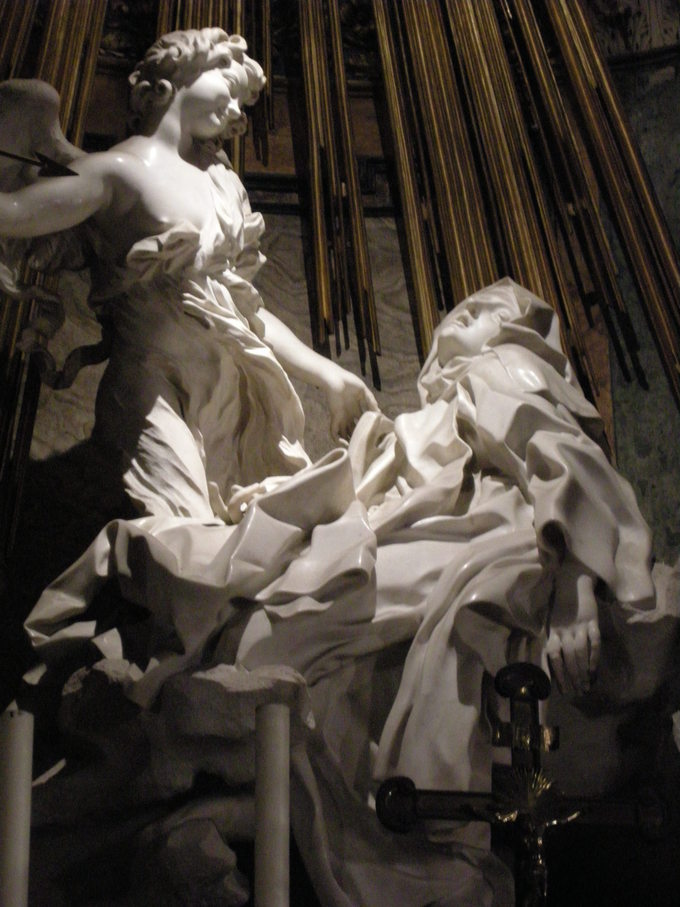
This is Saint Teresa’s description of the event that Bernini depicts:
Beside me, on the left, appeared an angel in bodily form…. He was not tall but short, and very beautiful; and his face was so aflame that he appeared to be one of the highest rank of angels, who seem to be all on fire…. In his hands I saw a great golden spear, and at the iron tip there appeared to be a point of fire. This he plunged into my heart several times so that it penetrated to my entrails. When he pulled it out I felt that he took them with it, and left me utterly consumed by the great love of God. The pain was so severe that it made me utter several moans. The sweetness caused by this intense pain is so extreme that one cannot possibly wish it to cease, nor is one’s soul content with anything but God. This is not a physical but a spiritual pain, though the body has some share in it—even a considerable share. Teresa of Ávila, The Life of Teresa of Jesus (1562–65)
Caravaggio, Calling of St. Matthew
Video URL: https://youtu.be/-yxSjUvh0g8?si=Dk8O1v2HVKtc2RR6
Artemisia Gentileschi, Judith Slaying Holofernes
Video URL: https://youtu.be/BHFuLS9NW6s?si=vnEUIW9kFo61J3WB
The story of Judith and Holofernes is recounted in the Book of Judith, a 2nd century text deemed apocryphal by the Jewish and Protestant traditions, but included in Catholic editions of the Bible. Like the story of David and Goliath, it was a popular subject of art in the Renaissance and Baroque periods. Rivulets of blood run down the white sheets, as Judith, a pious young widow from the Jewish city of Bethulia, beheads Holofernes, general of the Assyrian army that had besieged her city. Moved by the plight of her people and filled with trust in God, Judith took matters into her own hands. She coiffed her hair, donned her finest garments and entered the enemy camp under the pretense of bringing Holofernes information that would ensure his victory. Struck by her beauty, he invited her to dine, planning later to seduce her. As the biblical text recounts, “Holofernes was so enchanted with her that he drank far more wine than he had drunk on any other day in his life” (Judith 12:20). Judith saw her opportunity; with a prayer on her lips and a sword in her hand, she saved her people from destruction.
This particular painting, executed by Artemisia Gentileschi in Florence and now in the Uffizi, is one of the bloodiest and most vivid depictions of the scene, surpassing the version by Caravaggio, arch-realist of Baroque Rome, in its immediacy and shocking realism. Artemisia was certainly familiar with Caravaggio’s painting of the subject; her father Orazio, who was responsible for her artistic training, was Caravaggio’s friend and artistic follower. Caravaggio’s painting inspired, and perhaps even challenged, the young Artemisia.

A comparison between the two reveals not only her debt to the older artist, but also a series of pointed modifications that heighten the intensity of the physical struggle, the quantity of blood spilled, and the physical and psychological strength of Judith and her maidservant, Abra. In Artemisia’s painting, the bloody sheets are in the immediate foreground, close to the viewer’s space. Holofernes’s muscular body projects dynamically into the depicted space as bold areas of light and dark draw attention to his powerful limbs.
And, most importantly, whereas Caravaggio pairs his delicate Judith with a haggard attendant who merely looks on, her eyes wide with disbelief, Artemisia depicts two strong, young women working in unison, their sleeves rolled up, their gazes focused, their grips firm. Caravaggio’s Judith gracefully recoils from her gruesome task; Artemisia’s Judith does not flinch. Instead, she braces herself on the bed, as she presses Holofernes’s head down with one hand and pulls a large sword through his neck with the other. The creases at her wrists clearly show the physical strength required. Holofernes struggles in vain, the thrust of his arms countered by the more forceful movement of Abra, Judith’s accomplice in this grisly act.
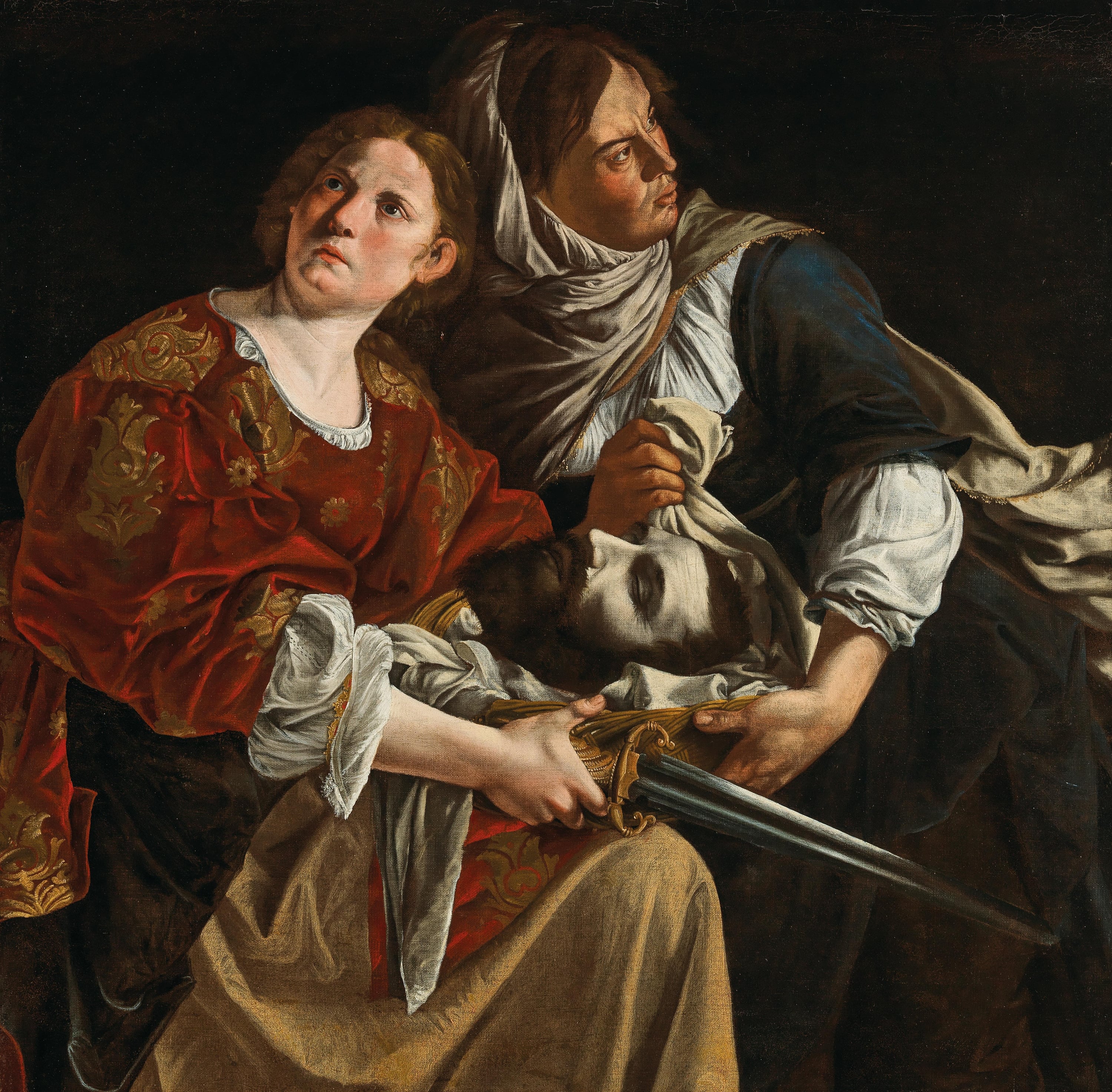
The Uffizi Judith Slaying Holofernes is Artemisia’s second telling of this narrative. The first, executed in Rome and now in the Capodimonte Museum in Naples, introduced the dynamic composition centered on the thrust and counter thrust of extended limbs. Artemisia refined the composition in the second (Uffizi) version. Small but significant adjustments reveal her growth in technical skill, her awareness of the local Florentine taste for sumptuous fabrics, and her thoughtful consideration of the expressive potential of each detail. Awkward passages of anatomy and proportion (such as Holofernes’ head) have been corrected, the colors and textures of the fabrics are now richer (notice the red velvet draped over Holofernes and the golden damask of Artemisia’s Judith’s dress), and Judith’s hair is more elaborately curled, in keeping with the biblical text’s emphasis on her self-adornment.
Most striking, however, is the portrayal of the blood. The Capodimonte version omits the blood that violently spurts from the neck of Holofernes. Like Caravaggio’s, the Uffizi painting places particular emphasis on this detail, and does so with even greater realism.
Framed by Judith’s arms, jets of blood now arc and descend in droplets that bespeckle her arms and dress. The pattern described by the spurting blood suggests Artemisia may have been familiar with her friend Galileo Galilei’s research on parabolic trajectories. Artemisia also modified the sword in the Uffizi version. The sword, here longer and held more vertically, prominently marks the painting’s central axis which extends from Abra’s arm to the blood that runs down the edge of the bed. This powerful visual axis reinforces the strength of the women and the violence of the deed. It is no accident that Judith’s sword-clenching fist is at the very center of the composition; imbued with divine strength, this widow’s hand is now the hand of God protecting the Israelites from their enemies.
Copyright: Dr. Esperança Camara, “Artemisia Gentileschi, Judith Slaying Holofernes,” in Smarthistory, July 19, 2015, accessed June 14, 2024, https://smarthistory.org/gentileschi-judith-slaying-holofernes/.
Diego Velázquez, Las Meninas
Video URL: https://youtu.be/IiTtGENiVOA?si=H2sKKo32EWd_UAU3
Anthony Van Dyck, Samson and Delilah
In his painting Samson and Delilah, Anthony van Dyck presents a moment filled with tension—a calm before a storm. Instead of depicting the climax of this Old Testament story, he represented the moment immediately before the action takes place. The heroic Samson is about to have his hair cut—removing the source of his superhuman strength. Lulled to sleep by his lover Delilah, the Philistine guards lie in wait ready to capture and imprison him as soon as the deed is done.
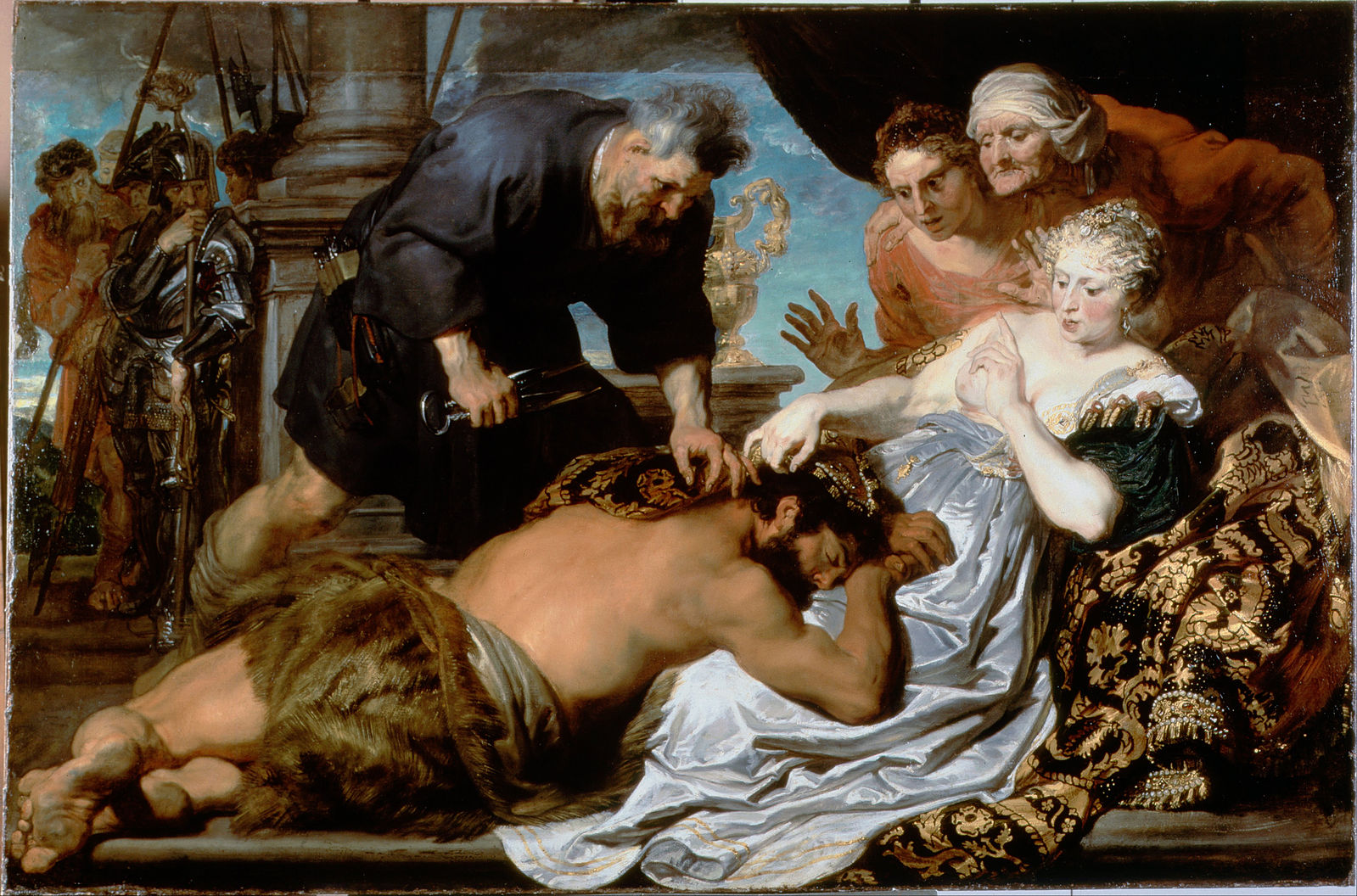
In Van Dyck’s scene, however, the focus is not the hero—Samson—but Delilah. The light within the painting is focused on her, while the edges of the canvas recede into darkness. She is shown bejewelled and in a state of undress, draped in luxurious silk and lounging on a bed covered with rich, brocaded fabric. Delilah’s soft and milky-white skin is in complete contrast to the swarthy Samson, who is covered with only a fur loincloth. All the action within the scene appears to rest on her as she raises a silencing finger, both to hush the guards and to command them into action.
The two women behind Delilah look on with interest and apprehension, waiting to see whether Samson will wake from his slumber. The guards, too, watch with anxiety, knowing that even their combined strength would be no match for the superhuman Samson. Van Dyck heightens the drama further by giving the barber what appear to be giant sheep shears, when normal scissors would do the same job.
Copyright: Helen Hillyard, “Anthony Van Dyck, Samson and Delilah,” in Smarthistory, February 6, 2016, accessed June 14, 2024, https://smarthistory.org/samson-and-delilah/.
Rembrandt, The Night Watch
Video URL: https://youtu.be/0D_rc92g27w?si=c2TUDjb2RCppWB86
Judith Leyster, Self-Portrait
Video URL: https://youtu.be/xt2M4HTw29A?si=KEJZ8519Rc0ol1d5
Symbolism and Meaning in Dutch Still Life Painting
Video URL: https://youtu.be/agy4wXMF9wg?si=ovRasj6noXEl_B-r
Willem Kalf, Still Life with a Silver Ewer
Video URL: https://youtu.be/5P3ap3rDmx4?si=tfhQXExtW8kTlXp8
Johannes Vermeer, The Glass of Wine
Video URL: https://youtu.be/uvA6YY4yHtM?si=451lCY_kQfmdpbss

